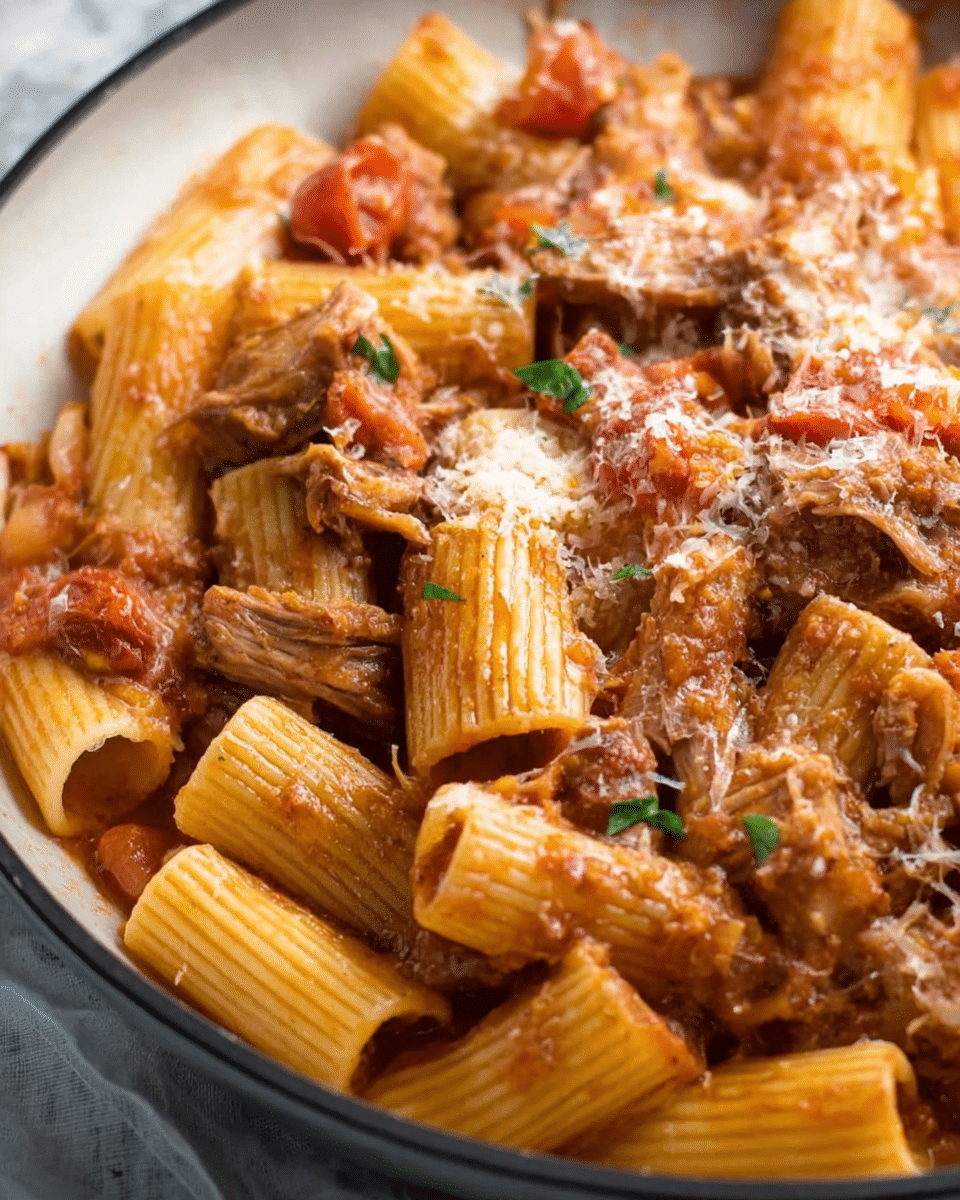Why Pork Ragout with Rigatoni Works So Well
What makes this dish so special is the slow-cooked pork ragout. The pork shoulder is a perfect choice for this recipe due to its marbled fat, which helps it become melt-in-your-mouth tender after a long simmer. Cooking it with onions, garlic, and herbs creates a base of deep, aromatic flavors, while the white wine and chicken broth add richness and complexity to the sauce.
The addition of tomatoes gives the ragout a natural sweetness and acidity, making it a perfect complement to the fatty pork. The rigatoni, with its ridged texture, acts like a little scoop, holding onto the flavorful sauce with each bite. The extra-virgin olive oil and freshly grated Parmesan that are added at the end add richness, while the optional arugula garnish provides a touch of freshness and peppery bite.
The Pork Shoulder: Tender and Flavorful
Pork shoulder is an ideal choice for this ragout because of its marbling, which makes it perfect for slow-cooking. As it simmers, the fat renders out, infusing the sauce with flavor and making the meat so tender that it can be shredded easily with two forks. This slow braising technique ensures that the pork absorbs all of the flavors from the aromatics, wine, and tomatoes, resulting in a rich, succulent ragout.
The seasoning of salt and pepper before browning the pork ensures that the meat has a flavorful crust when seared, which contributes additional depth to the ragout. The browning also enhances the overall flavor profile, creating a savory base that complements the other ingredients.
The Aromatics and Herbs: Building Flavor
The base of this ragout relies on the deep, savory flavors of onions and garlic, which are cooked slowly to develop a rich sweetness. Cooking the onions with salt helps them release their natural moisture, allowing them to become caramelized and tender. Adding garlic at the end of the onion cooking time ensures that it infuses the dish without becoming bitter.
The addition of thyme, rosemary, and bay leaf creates a fragrant herbal blend that complements the richness of the pork. Tying these herbs into a bundle with butcher’s twine makes it easy to remove them once the dish is finished, allowing their flavors to infuse the sauce without leaving any leaves or stems behind.
The Sauce: Rich, Tangy, and Savory
The sauce in this ragout is where all the magic happens. Deglazing the pot with white wine helps lift any caramelized bits from the bottom of the pot, adding additional layers of flavor to the sauce. Reducing the wine for 6-10 minutes intensifies its flavor and blends it seamlessly with the other ingredients.
Adding chicken broth and crushed tomatoes to the wine creates a balanced sauce with both savory depth and a touch of sweetness. The Parmesan rind adds a subtle umami richness that enhances the overall complexity of the sauce, while the pinch of red chile flakes introduces just a hint of heat, balancing the richness of the pork and creaminess of the sauce.
Cooking the Rigatoni: Perfectly Al Dente
Rigatoni is the perfect pasta choice for this dish because its ridged surface helps to capture the ragout sauce, ensuring every bite is full of flavor. Cooking the rigatoni slightly under al dente ensures that it will continue to cook in the sauce for an additional 2 minutes, allowing the pasta to absorb the flavors of the ragout. This technique allows the pasta to be fully incorporated into the dish, adding texture and making every bite more flavorful.
Assembling the Dish: A Beautiful Balance of Flavor and Texture
Once the pork is shredded and mixed with the sauce, it’s time to combine the ragout with the rigatoni. By adding the cooked pasta to the sauce and finishing the cooking process together, the pasta takes on the delicious, savory flavors of the ragout while maintaining a firm texture. Stirring in the olive oil and half of the grated Parmesan at the end adds richness to the sauce, while the remaining Parmesan is sprinkled on top just before serving.
The optional garnish of arugula adds a fresh, peppery contrast to the rich and hearty ragout, creating a delightful balance of flavors and textures.
Serving Suggestions
Pork Ragout with Rigatoni is an incredibly satisfying dish on its own, but it can be paired with a variety of sides to complete the meal. A simple green salad with a tangy vinaigrette helps to cut through the richness of the ragout, providing a refreshing contrast. For an added indulgence, serve the ragout with a side of garlic bread or crusty bread to soak up the flavorful sauce.
A glass of red wine, such as a Chianti or Sangiovese, would pair beautifully with the hearty flavors of the ragout, making this a perfect dish for a dinner party or special occasion.
Nutritional Breakdown
Each serving of Pork Ragout with Rigatoni contains approximately 519 calories, making it a hearty and filling meal. The dish is rich in protein, with 36g per serving, thanks to the pork shoulder. The 32g of fat, including 9g of saturated fat, comes from the pork, olive oil, and Parmesan cheese, contributing to the dish’s richness.
With 55g of carbohydrates, mostly from the rigatoni, and 5g of fiber, the dish offers a satisfying balance of macronutrients. The ragout also contains 8g of sugar, which comes naturally from the tomatoes, and 992mg of sodium, which can be adjusted by using low-sodium broth or tomatoes if desired.
Conclusion: A Hearty and Flavorful Meal
In conclusion, Pork Ragout with Rigatoni is a rich, flavorful, and hearty dish that’s perfect for any occasion. The tender, slow-cooked pork, combined with the savory sauce and perfectly cooked rigatoni, makes for a satisfying meal that will impress family and guests alike. Whether you’re serving it for a weeknight dinner or a special celebration, this dish provides comfort and elegance with minimal effort. The balance of flavors from the pork, tomatoes, and herbs makes this ragout a memorable meal that will leave everyone coming back for seconds.






